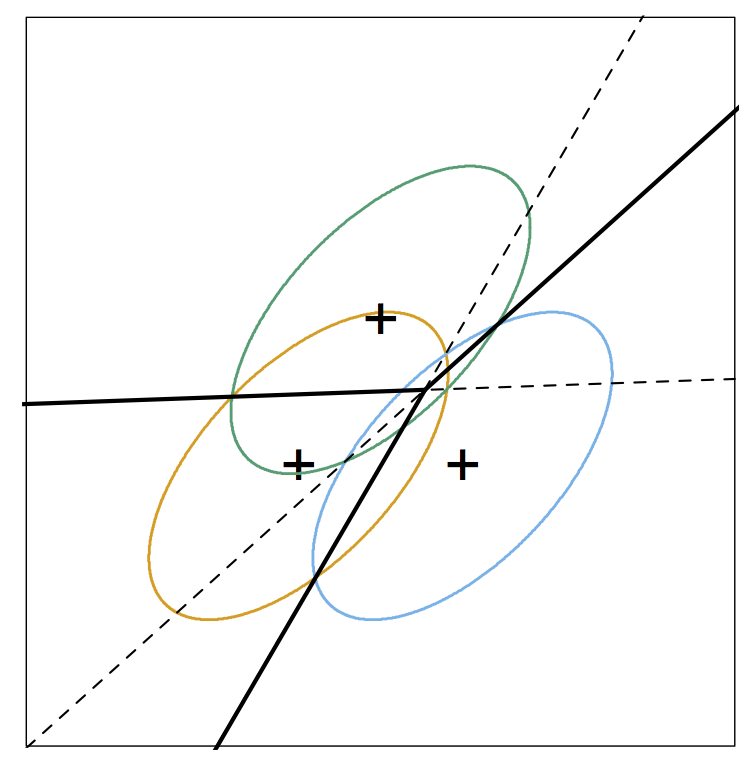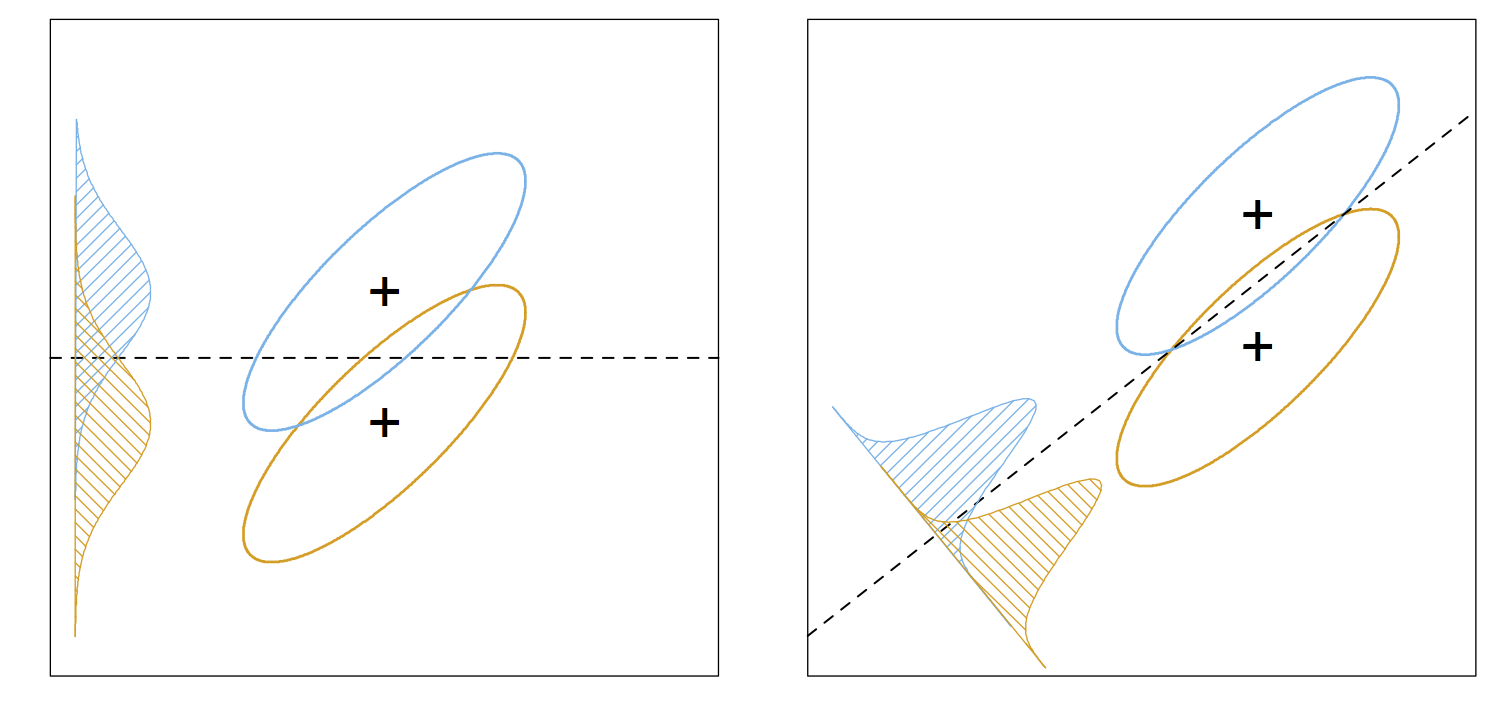Stat 470/670 Lecture 26: Linear Discriminant
Analysis
Julia Fukuyama
Today: Linear discriminant analysis
- I’ll give you two interpretations of linear discriminant analysis so
that you have some idea where it comes from and to give you intuition
into when it is likely to perform well.
- We’ll go back to the congressional voting data and see how LDA helps
us understand other divisions among the senators.
Problem Setup
- We have \(p\) of “predictor”
variables and \(n\) cases.
- We have a special “response” variable, and we are interested in how
it is related to the predictors.
- Today we will talk about linear discriminant analysis and the case
where the response is categorical, so something like party ID.
Potential questions: Is there a relationship between the response and
the predictors? If so, what is that relationship? How good of a job can
the predictor variables do in explaining the response? Which predictors
are most important?
LDA: Probabilistic Interpretation
Reading: Section 4.3 in ESL
LDA is based on a simple probabilistic model, where we assume that
within each group, the predictor variables come from a multivariate
normal distribution with a group-specific mean and a covariance matrix
that is the same for each group.
In math: Let \(\mathbf x_i \in \mathbb
R^p\) be the values for the predictor variables for case \(i\), and let \(y_i \in \{1,2,\ldots, K\}\) describe the
group membership for case \(i\). Then
our model is \[
\mathbf x_i \sim \mathcal N(\mathbf \mu_{y_i}, \mathbf \Sigma)
\]
- \(\mathbf \mu_{y_i} \in \mathbb
R^p\) is the group mean for observation \(i\).
- \(\mathbf \Sigma \in \mathbb R^{p \times
p}\) is the within-group covariance matrix.
In pictures:

- In this case, we have three classes.
- Each class comes from a bivariate normal distribution with its own
centroid (the + mark on the graph).
- Each class has the same covariance. The ellipse indicates a level
curve for the density of each class, and each class having the same
covariance corresponds to the ellipses being the same shape.
- The solid lines indicate the Bayes decision boundaries.
If we knew \(\mathbf \mu_{y_i}\) and
\(\mathbf \Sigma\), we could use Bayes’
rule to obtain \(\mathbf P(y_i \mid \mathbf
x_i)\).
However, we don’t know either, and so we estimate them from the data
and use the estimates to predict which group each case belongs to.
This procedure turns out to give linear decision boundaries, hence
the name linear discriminant analysis.
LDA: Projection Interpretation
Reading: ESL 4.3.3
The probabilistic interpretation of LDA is nice, but what makes it
particularly useful is that it also gives us an informative
low-dimensional projection of the data.
In PCA, we projected the data so as to maximize the variance of the
projection, but we noticed that this projection won’t necessarily be
informative about the groups we are interested in.
In LDA, if we have \(K\) groups, we
can project the data into \(K-1\)
dimensions, the space spanned by the estimated group means, and retain
all the information necessary for classification using the model we
defined above.
Fisher’s linear discriminant
Fisher posed a different problem and ended up with the same solution.
He was interested in projecting the predictors in such a way as to
maximize the ratio of the within-class to between-class variance.

If you want more details you can read about it in Section 4.3.3 of
ESL, but the main point to take away here is that in this derivation of
LDA, there is no reference to a probabilistic model or to Gaussian
distributions. Therefore, we don’t need to assume anything about our
predictors for LDA to be a reasonable tool for predicting group
membership.
LDA biplots
Reading: Greenacre
Chapter 11
Since LDA gives a projection of the data onto a lower-dimensional
space, LDA biplots work the same way as PCA biplots:
- We get biplot points for the observations and biplot axes for the
variables.
- Variables with longer biplot axes are more “important” for
explaining the response.
- When we look at an LDA biplot, we look at which direction each class
centroid is in, and then identify biplot axes that point in that
direction (or in the opposite direction) and have large magnitudes.
These axes will correspond to the most important variables for
explaining that class.
LDA: Practical considerations
LDA will fail/not work well if
- You have more variables than observations. Computationally, we need
to invert an estimate of the covariance matrix, and so if \(p > n - K\), the estimated covariance
will be singular and this will be impossible.
- Even if you \(p\) strictly less
than \(n-K\), LDA still might not
perform that well. In general, you want to have \(p\) substantially less than \(n\), and it often helps to filter out
variables you don’t think will be useful before running LDA.
Note: The problem of \(p\) on
the same order or larger than \(n\)
motivated work on a large class of models referred to as
regularized, which you might see in your other courses.
- You have outliers in the predictors. This is because the procedure
relies on non-robust estimates of the mean and the covariance.

